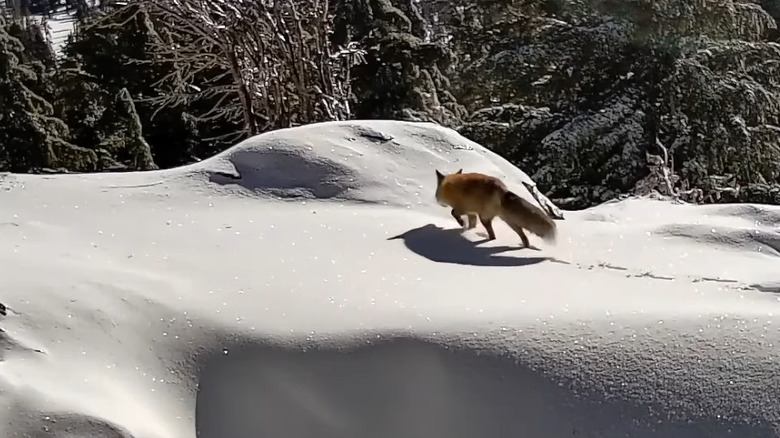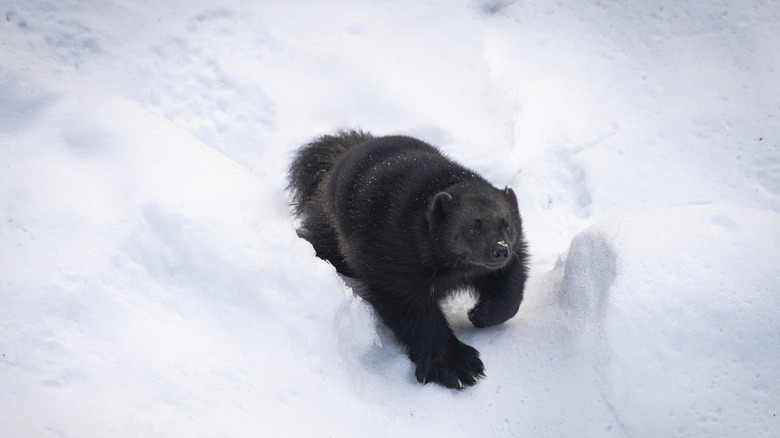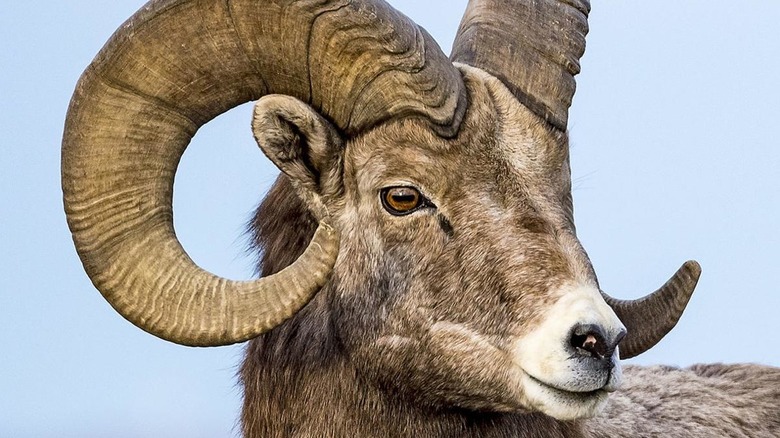Yosemite's 5 Rare Animals That Tourists Would Be Lucky To See
Some travelers head to Yosemite National Park to scale its iconic national wonder, Half Dome. Others come to immerse themselves in nature, backpacking in the park's backcountry wilderness or exploring Hetch Hetchy, Yosemite's secret valley. For some, however, the appeal isn't in the mirror-like alpine lakes or towering granite cliffs. They're drawn to Yosemite for its wildlife.
The park is home to hundreds of animal species, from the small lizards that skitter across the rocks to the birds that perch in the trees, some of which are found in only a few places on Earth. Particularly lucky and determined visitors catch a glimpse of Yosemite's rarest inhabitants: Sierra Nevada red foxes, Pacific fishers, wolverines, Sierra Nevada bighorn sheep, and great gray owls.
There's no shortage of incredible creatures in Yosemite. It ranks among the best national parks in America for bird lovers, and while it's not one of those national parks where you're almost guaranteed to see a bear, your chances aren't bad. However, spotting the park's more elusive inhabitants requires a plan. Part of what makes Yosemite such a fantastic place to look for wildlife is its many different wilderness habitats, which attract a wide range of species. While there's no way to ensure a sighting, you can improve your odds by learning about the animals you hope to see and planning accordingly. In addition to knowledge and luck, you'll need patience. The more time you spend in Yosemite, the better your chances of encountering its rarest wildlife.
Sierra Nevada red fox
Seeing Yosemite National Park quiet and still, blanketed in snow, is breathtaking in its own right. Seeing a tiny orange fox dart across the landscape is a once-in-a-lifetime moment. You are likely to see a California Gray Fox and might encounter red foxes in the park, but spotting a Sierra Nevada Red Fox is an extremely rare experience — one that even park rangers and wildlife biologists rarely have. For a long time, these proposed endangered animals were believed to be completely gone from Yosemite until 2014, when a motion-sensor camera captured one exploring the snowy landscape.
If you're hoping to find this very elusive little creature, you'd better be up for a challenge. In the summer, you might spot one in extremely remote, high-elevation parts of the park. They've adapted to live in some of the harshest environments imaginable — places where humans struggle to linger — making camping out and waiting for a Sierra Nevada red fox to appear incredibly difficult. Even if you make your way up into the freezing mountains they call home, these shy animals will probably make it their mission to avoid you — and everyone else. To make things trickier, they are most active at night, though you might get lucky around sunrise or sunset when you can still see a little.
If you think you've spotted one, take a photo and report your sighting to the California Department of Fish and Wildlife. Your contribution could help researchers learn more about these incredible animals.
Pacific fisher
You're looking up into the branches of an evergreen tree when you spot something unexpected: A pointy little face that looks like a cross between a bear cub and a stoat. That's a Pacific fisher, a fluffy, 3-foot-long weasel that lives in trees, hunts rabbits and birds, and snacks on bugs, fruit, and fungi. These remarkable creatures live in the forest and make dens for their little kits in tree holes. They're also endangered and notoriously hard to find, not just because of their small population but also because they blend into their forest home. You could easily be close to one and never know it. Even wildlife biologists and park rangers sometimes spend years in Yosemite National Park without ever catching a glimpse. That doesn't mean it's impossible, though.
Most fisher sightings in Yosemite come from baited cameras set up by rangers studying these species. Many fishers are even tagged, so experts can track their movements and help keep them safe. If you're hoping to look for them yourself, you'll want to spend time in the forested areas between the Merced River and the border of Sequoia National Forest. While you have to be very lucky to spot a fisher, keep your eyes peeled for pine martens and other smaller weasels around the park. You might spot mountain weasels among rock piles on the Yosemite Valley floor or see a marten on a winter day in Tuolumne Meadows.
Wolverine
The wolverine might be the rarest animal in Yellowstone. As far as anyone knows, there is only one, according to a report by NBC News. These massive weasels — which resemble small bears with pale neck ruffs — can weigh up to 40 pounds and stretch more than 3 and 1/2 feet from nose to tail. As Smithsonian Magazine notes, the Sierra Nevada mountains were once home to wolverines, but by the early 1920s, the species had been wiped out in California due to hunting. Today, the climate crisis has reduced the amount of deep snow available later in the year, which wolverines need to raise their kits, putting their numbers at risk of further decline in the areas of the U.S. where they still live. Still, there's a glimmer of hope for California's wolverines. Since the early 2000s, there have been occasional sightings along the West Coast.
Then, in 2023, a Yosemite park ranger spotted a wolverine within the park. It's unknown whether the animal stayed, but it's entirely possible that at least one of these rarely-seen animals still roams the wild parts of Yosemite, avoiding detection as it hunts for its next meal among the granite cliffs. Yosemite is about the size of Rhode Island, though, so the odds of spotting a single wolverine are slim.
If you want to try, you'll need to plan a wilderness backpacking trip into Yosemite's backcountry. Wolverines are active during the day and typically found in cold, snowy mountain peaks. Experts hope to gather more information about Yosemite's rarest resident, so if you think that you have caught a glimpse, found tracks, or seen any other sign that might belong to a wolverine, document what you can and inform a park ranger right away.
Sierra Nevada bighorn sheep
Hopping around on snowy mountainsides, these horned sheep live comfortably in rugged conditions that would take humans years of training to navigate. Once pushed to the brink of extinction by contagious diseases from domestic sheep, Sierra Nevada bighorn sheep have made an impressive recovery. Their population is believed to have risen to over 300 in the Sierra Nevada range.
Today, several herds of Sierra Nevada bighorn sheep live in Yosemite National Park. They inhabit high-elevation areas on rocky mountainsides in the park's backcountry, particularly around the Cathedral Range. Spotting them isn't easy – you will very likely need binoculars or a spotting scope. They have evolved to blend in perfectly with the rocky landscape, so it's entirely possible to be near them without noticing.
If you do happen to see any bighorn sheep in Yosemite, or anywhere in the Sierra Nevadas, make sure to note down your observations, including how many you saw, where, and when. If possible, take photos and report your sighting to the California Department of Fish and Wildlife at asksnbs@wildlife.ca.gov so they can help to protect these animals.
Yosemite's distinct great gray owl
Yosemite is one of the best birdwatching destinations in the country, and among its most impressive species for birders to seek out is the great gray owl. Spotting any owl is a rare treat, but heading out into the gorgeous Yosemite landscape in the stillness of dusk or dawn and seeing the wide, silent wings of a swooping owl is an unforgettable experience. Great gray owls are especially impressive to see because they are so large — sometimes reaching a wingspan of five feet. However, this is no easy task. You can hike along Glacier Point Road and scan the meadow near Taft Point Parking Lot, or head toward the edge of Ackerson Meadow and look at the trees around you. If you're lucky, you might just see a silhouette.
As unbelievable as it may seem after days of searching Yosemite's pine forests, most of California's endangered great gray owls live within the park. Intriguingly, scientists discovered evidence in 2010 that they are even rarer than previously thought — they represent a genetically and behaviorally distinct subspecies, likely because they are so separate from other owls up in the Sierra Nevada mountains.





